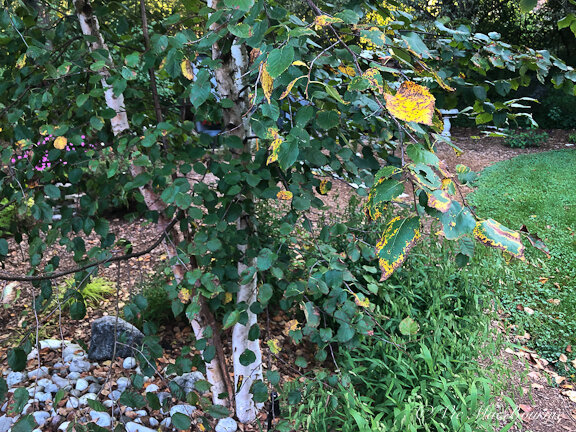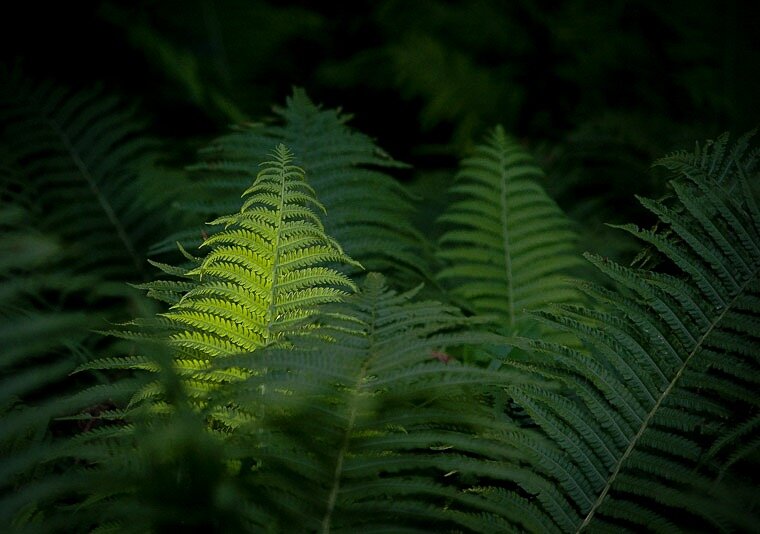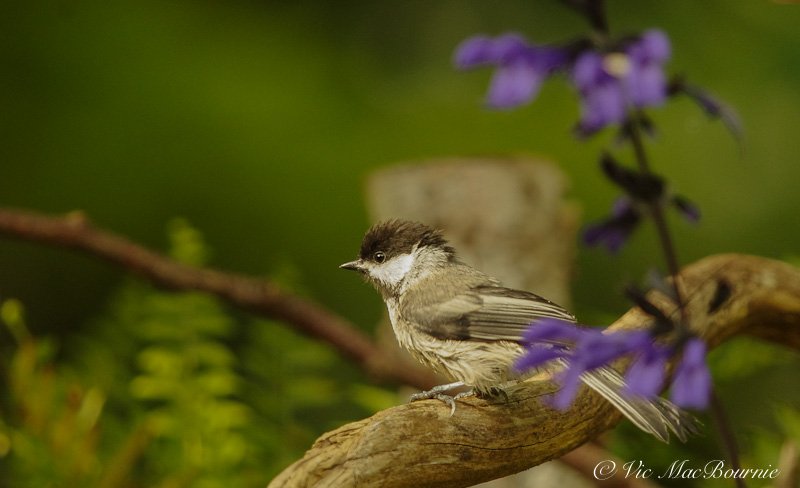Why birch tree leaves turn yellow and fall off prematurely
If the leaves of your birch tree are turning yellow and falling off prematurely, it is likely due to a lack of water. Birch trees are shallow rooted and unable to access water deep in the ground. The solution is to deep water the tree regularly.
If your birch trees are showing early signs of stress with yellowing leaves falling off the tree earlier than expected, you are likely not alone.
It’s been a difficult year for trees throughout North America and parts of Europe with extreme heat and periods of drought that can really tax our urban forests. One just has to look at the wildfires raging around the globe to recognize the difficulty many trees are facing this year.
In our case, the combination of extreme heat (hitting 42-43C or more than 105F), periods of very little rain and a sandy soil that struggles to hold a lot of water for any period of time, has caused some minor stress to our clump birches.
I’ve noticed other birches in the area struggling much in the same way.
One of our birch clumps losing its leaves a little prematurely following a hot, dry summer.
Why are my birch leaves yellowing and falling off
Birches may be feeling the heat more than many other trees because they have a very shallow root structure that fails to go deep enough into the ground to tap into the cooler and more moist soil below the surface. Severe heat and drought easily dries out the top foot or two of the soil and causes some stress to the trees.
Usually, the water from melting snow keeps the soil moist throughout the spring and into the early part of summer, but without significant rainfall during mid-summer combined with severe heat, the trees will show stress by late summer into the fall. Many gardeners may think the trees are exhibiting typical fall leaf drop as the leaves begin to yellow prematurely. But, be careful the leaf drop is not related to stress from lack of water.
The yellowing leaves could also be caused by chlorosis – a mineral difficiency caused by a lack of iron. This is usually the result of alkaline soil and the trees inability to absorb iron in the soil. You’ll know this problem by observing the leaves which turn yellow with green veins. Treatment is relatively simple.
In urban landscapes, Birch trees are often competing with turf grass for the available water, and because the grass absorbs more than its share of water, the trees often are forced to go without, even after a rainstorm.
Give your trees a deep watering
If your trees are surrounded by grass, be sure to take the time to deep-water them by leaving the hose on for several hours (4-6 hours) at a slow but steady trickle.
Do not use a sprinkler for this deep watering. The idea is to get water deep into the ground. Remember, you are not trying to water the lawn around the tree. Move the hose around the perimeter of the tree at or around the drip line (not the trunk of the tree).
It’s never a good idea to have grass coming right up to the trunk of your tree.
If possible, remove all the grass from beneath the tree in a wide berth that replicates the drip line of the tree branches. Obviously, a young tree would need much less grass removed than a more mature one. As the tree grows, consider removing more and more grass to reflect the expanding root structure.
Why do urban birch trees have a short lifespan
One of many reasons birch trees have a short lifespan in an urban environment is caused by turf grass that often surrounds the trees and robs them of both nutrients and water. If it’s not turf absorbing the water around the trees before it can get to the trees’ roots, the water is often blocked by hardscaping that is covering the tree’s roots.
Whether it’s a concrete driveway, walkway or patio, this hardscaping restricts water from getting to the root system, essentially starving the trees of essential moisture.
For more on Birch Trees in the Woodland garden check out my other articles:
Planting and caring for a birch grove
In our garden, we have three clump birches about 10-12 feet apart forming a small birch grove of about ten tree trunks in total.
The problem is not grass running up to our clump birches, but they are surrounded by various plants, including ornamental grasses, sedum and a host of perennials. The birch clumps encircle a large dry-river bed that does not rob the roots of any water and provides a non-organic mulch helping to shade the soil above the trees’ roots.
The biggest problem for our clump birches is likely our sandy soil which does not hold water well at all. Knowing this, it is important to mulch the soil around the trees and ensure a deep watering during hot, dry spells every 7-10 days.
Since I have noticed the problem, I will ensure that the trees are well watered between now and the first snows of winter to ensure they are fully nourished and healthy for the long winter ahead.
Will losing leaves prematurely cause any long-term problems?
It’s a question every tree lover is going to be concerned about but, rest assured, it’s highly unlikely that a season of mild drought and resulting loss of leaves will cause a problem with the tree next season.
But prolonged drought, without any intervention from the homeowner could, in time, lead to the slow decline of the tree. Take action before it’s too late to ensure the tree gets several deep waterings prior to going into the winter months.
Why plant a birch grove
The decision to plant a mini birch grove was inspired by woodland walks where I came across large swaths of birch trees growing together and forming an impressive sight spring, summer, fall and winter. Creating a small grove of birch trees helps to recreate the same feelings I had during the woodland walks, but also creates a birch canopy that attracts birds looking for insects in spring. Birch are an excellent native tree, and one that attracts a host of insects that are crucial for birds in spring looking for protein to feed their hatchlings.
Can Trees communicate
I am also a firm believer that trees not only enjoy the company of their own kind, but benefit from sharing a space with other similar trees. The New York Times best selling book, The Hidden Life of Trees, certainly verifies these views and even suggests – complete with scientific evidence – that trees communicate with one another and even share resources when necessary.
If nothing else, the birch grove will create it’s own mini-environment by shading the ground beneath the canopy helping to preserve the ground water that is obviously important to their survival.
I look forward to the day – not far off – when all three tree canopies merge above ground and all the roots below ground are introduced to one another and begin working together as a single entity.
Meanwhile, I’ll be busy deep watering the trees so that next year they will look their best and weather whatever Mother Nature throws at them.












Adding a few native plants to your garden every year will go a long way to building the landscape of your dreams.